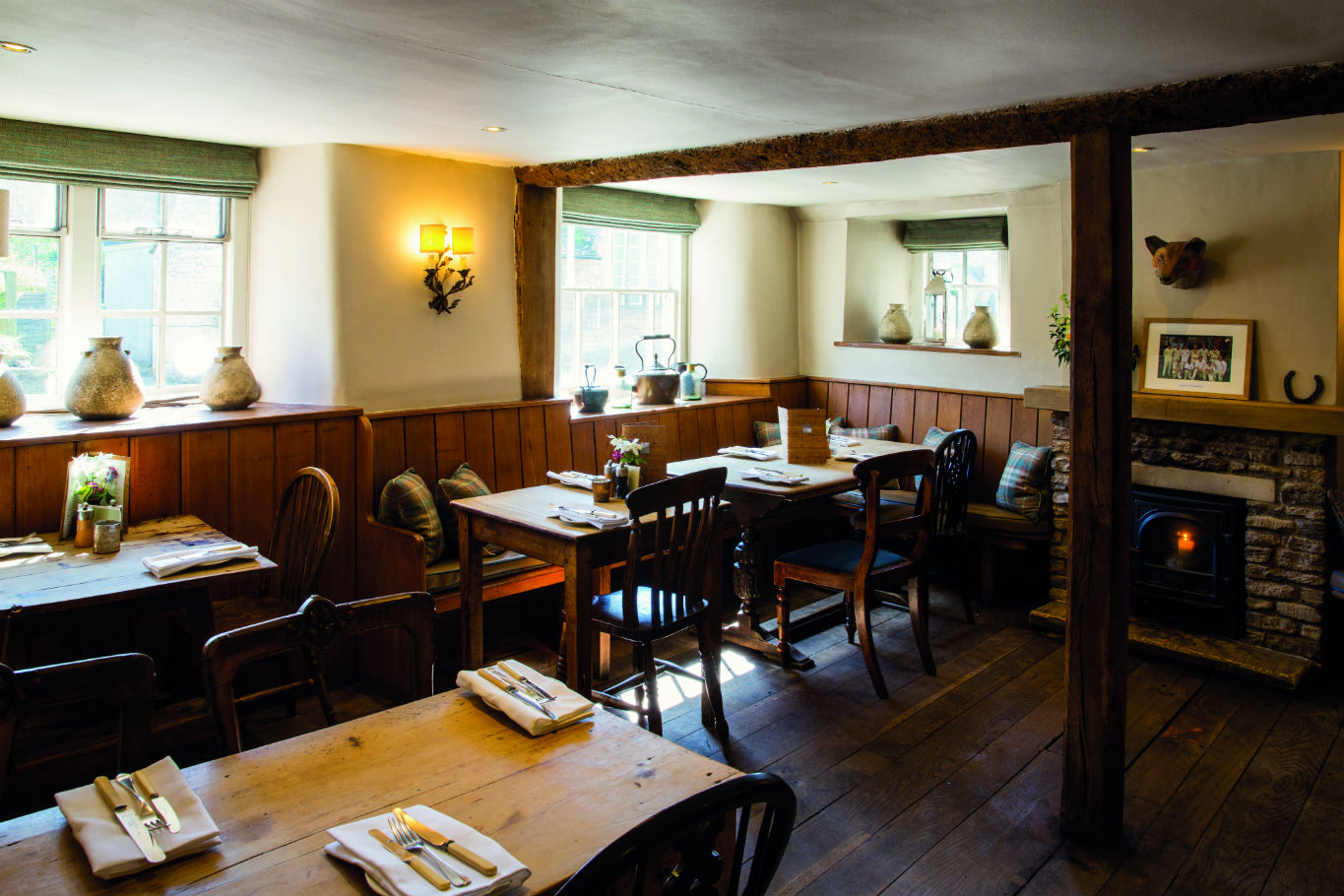Where exactly is it? On the un-glam sounding B4425, between much-photographed Bibury (of which more later) and Cirencester. Barnsley’s a honeypot village built up on both sides of the main road, its architecture understatedly perfect, all stone cottages, waterfalls of wisteria and old piles glimpsable behind towering bushes.
Interior: Discuss. Formerly a private house, the pub became known as the Village Inn in the 1920s. It changed its name from ‘inn’ to ‘pub’ half a century later, and wears its antiquity simply: stone floors, cosy corners, inglenook fireplaces illuminated by (on our summer visit) flickering candles, and an atmospheric sharing table, where natural light pours in through the windows. There are two dining rooms, close-packed so you can hear the conversations two tables away, and a spacious outdoor terrace, set back from the road.

What was good about the rooms? Just six to choose from, all recently enjoying a makeover to bring them in line with those at upmarket sister property Barnsley House, over the road. Ours was smallish, with a petite window, but impeccably turned out, with retro Roberts radio and muted stone colour palette, super-lux heavy bed linen, awesome pillows and blackout curtains so dark we slept in way later than usual. There’s decent tea and coffee facilities and iced tap water on hand in a stylish silver jug. Best of all? The huge bathroom. In fact, it’s a room in itself, with rain shower cubicle enormo enough for two, a freestanding bath and lots of luxe toiletries. Oh my.
Anything on the snagging list? The ceilings and white-painted beams were fairly low and needed to be ducked carefully when going to the bathroom. The bedside table was on a sloping section of floor causing glasses to slide off its polished top, Poltergeist-style (actually the cause of much mirth). The wifi didn’t really work despite repeated attempts; in the end we released ourselves from our innate phone-dependencies. With such a tiny window, we did find the room rather hot (and too noisy when we opened it as the vehicles thunder along the main road).

For dinner? Solid seasonal fare, with traditional butcher’s cuts picked from Paddock Farm (at the bottom of the road) and veg from their sizeable plot. We enjoyed the food: while not experimental, classics such as burrata with tomato, and mackerel rillettes with fennel and beetroot, packed in some flavour; and a main of deceptively simple lamb chops from the nearby farm was, with its red wine jus and wild mushrooms, an example of English food done beautifully. It was almost like – we imagined whimsically – eating on someone’s farm.
What’s the service like? Mostly good. Very friendly and extremely rapid delivery of the room-temperature starters. Then a bit of a wait (a decent house wine filled the gap) and one wrong main on the table. On departure, there was a mix-up with the bill, which took just slightly too long to resolve.

So let’s talk breakfast. It’s a continental offer spread lavishly out: yoghurts, top quality summer fruit citrus-and-melon salad, pastries. Our full English was impressive in the meat department (the smoky bacon especially so), but the requested soft-poached eggs arrived hard.
Any other facilities? Not right here, so you’ll need to go over the road for treatments at the Barnsley House Spa, reached down a meandering garden path. For visual stimulation the nearby hotel’s very own cinema holds twice-weekly screenings (Wednesdays and Sundays).

Don’t miss: the Potager restaurant at Barnsley House. Two courses at £26 may seem a steepish lunch offer, but the surroundings are exquisite. We sat pondside by faux Grecian temple, and there’s also an idyliic eating terrace with views onto the lawns and gardens beyond, both formal and wild, designed by Rosemary Verey; an essential post-prandial stroll. Try starters of Portland crab with lemon mayonnaise, or courgette carpaccio with ricotta fritters and red onion jam; and for mains, skate wing with avocado and capers, or goujons of lemon sole.
Day trip? Nearby Bibury is a must, but our advice is to visit early or late, as its watery meadows and famous terrace of medieval cottages (Arlington Row) get mobbed with visitors. Bourton-on-the-Water, twenty minutes’ drive, suffers the same ignominy, while Burford has antiques shops lining its hilly high street. We rated Cirencester, just five minutes’ drive, a more ‘real’ town with its foodie Corn Hall (try Made By Bob for lunch) and Cirencester Park on picturesque Cecily Hill.
Main image: PR


